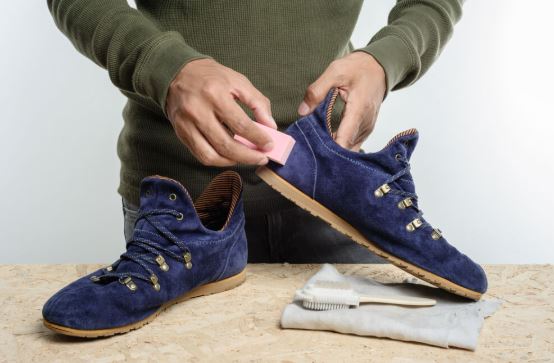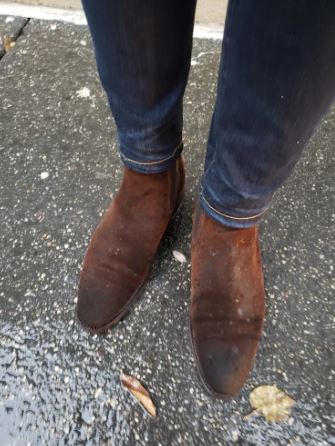Reviving Wet Suede Footwear: A Complete Guide
Suede shoes may be stylish and refined, but they’re also notoriously sensitive to moisture. When caught in the rain or exposed to water, these shoes need thoughtful care to bounce back without permanent damage. This guide walks you through the essential steps for restoring wet suede and removing unwanted marks or stains without harming the delicate texture.
Let the Shoes Air Dry Naturally
If your suede shoes get soaked, the first step is to allow them to dry out in a natural environment. Choose a spot that’s well-ventilated but away from any direct heat sources such as radiators or sunlight. Excessive heat can distort the shape and texture of suede, making it brittle or discolored.
Avoid the temptation to wipe or rub the shoes while wet. At this stage, the material is fragile and prone to damage. Instead, just place them in a quiet corner and allow time to do its work.

Use Paper to Retain Shape
When suede absorbs water, it tends to shrink and lose its structure. To prevent this from happening, gently fill each shoe with plain tissue paper or unprinted paper towels. Focus on mimicking the shape of your foot without forcing too much bulk into the shoe.
While newspaper is commonly used, be cautious: the ink can transfer to the inner lining, especially if the shoes are heavily soaked. Stick with blank, absorbent materials if you want to play it safe.
Brush Off Dirt Once Dry
Once the shoes are no longer damp, it’s time to clean off any surface grime. Use a soft-bristled suede brush or even a clean toothbrush to sweep away dirt or debris. Move the brush gently in the direction of the suede’s natural grain. Trying to scrub too hard or brushing against the grain can cause more harm than good.
If there’s still visible dirt, don’t worry. The goal is to do a light cleanup now and return for deeper stain removal after the shoe is fully restored.

Be Patient: Water Alone Won’t Destroy Suede
A common misconception is that suede can’t survive moisture. In truth, suede can recover just fine if dried properly. The key is resisting the urge to scrub or apply heat. Allowing the material to dry in a controlled way will help preserve its texture and prevent irreversible damage.
Trying to fix stains or flaws too early—when the material is still damp—can result in tearing the surface or permanently distorting the nap. Give the shoes time and work slowly through each stage.
Restore the Nap with Gentle Brushing
After the shoes are dry and reasonably clean, it’s time to focus on restoring their soft, fuzzy finish. Suede has a distinctive nap—tiny raised fibers that create its velvety texture. Over time or with exposure to moisture, these fibers can become flat or stiff.
Using a suede brush, go over the entire surface using gentle, circular strokes. This helps lift the nap and bring back the softness. If the shoes are older or heavily worn, this won’t restore them completely, but it will significantly improve their appearance.
Add a Protective Barrier
To shield your shoes from future moisture mishaps, treat them with a specialized suede-protectant spray. This invisible coating repels water and blocks stains while preserving the texture of the suede. Follow the manufacturer’s instructions, and be sure to apply the spray in a well-ventilated area.
Reapply the protectant periodically, especially if you wear your suede shoes often or live in a damp climate. Prevention is always easier than restoration when it comes to suede.
Tackling Common Stains on Suede Shoes
Even after they’re dry, suede shoes can retain marks and discolorations. Fortunately, there are several simple ways to treat these blemishes without risking further harm.
Make Sure Shoes Are Fully Dry First
Before attempting any stain removal, verify that the shoes are completely dry. Cleaning wet suede can result in warping or even cracking the material. Once you’re certain the shoes have dried fully, you can begin tackling individual stains.
Use a Suede Eraser for Most Marks
A suede eraser is one of the best tools available for general stain removal. These are specially designed to lift dirt and discoloration from the nap without damaging the surface. Use light pressure and rub in small circles over the stained area. Avoid being too aggressive; patience yields the best results.
Afterward, use a clean suede brush to smooth the nap and remove any eraser residue. You’ll be amazed at how much grime these erasers can lift with minimal effort.
Remove Salt and Water Stains with Vinegar
For white rings or marks caused by salt and mineral deposits, a vinegar solution can work wonders. Mix equal parts white vinegar and lukewarm water. Lightly dab the stained area with a cloth dipped in the mixture—do not soak the shoe.
Let the area dry naturally, then brush the nap back into place. Vinegar is also effective against some food stains and minor discolorations.
Tackle Oil-Based Marks with Absorbent Powders
Oily stains are notoriously tough on suede, but you can often minimize their impact using powders like cornstarch or talcum. Sprinkle the powder directly onto the stained spot and let it sit overnight. The powder will draw out some of the oil.
In the morning, use a dry brush to clear the residue and reassess the stain. You may need to repeat the process or combine it with other methods for stubborn spots.
Remove Ink with Alcohol
Ink stains can be treated using isopropyl alcohol and cotton balls. Dab gently at the mark until the ink lifts. Avoid rubbing or applying too much alcohol, as it can bleach the suede.
Once the stain is gone, brush the area lightly to restore the texture. In some cases, a suede eraser can help finish the job.

Conclusion
Suede shoes might seem high-maintenance, but a bit of knowledge and care goes a long way. By following these careful drying and cleaning steps, you can restore most water-damaged shoes to their former look. Regular maintenance and protective treatments will help keep your shoes ready for whatever the weather throws at them—just maybe not a thunderstorm.
If all else fails and your shoes remain stained or deformed, don’t hesitate to consult a professional cleaner. Sometimes expert tools and experience are the best option for saving your favorite pair.
FAQs about Fixing Wet Suede Shoes
What should I do first when my suede shoes get wet?
Allow them to dry in a cool, shaded area with good airflow. Avoid heaters and sunlight to prevent shrinking and cracking.

Can I clean suede shoes while they’re still wet?
No, always wait until the suede is completely dry before attempting any cleaning or stain removal to avoid damaging the texture.
How can I help wet suede shoes keep their shape?
Lightly stuff them with tissue paper or unprinted paper towels to maintain their form and absorb excess moisture.
What kind of brush should I use on suede?
Use a suede brush or soft-bristled toothbrush to gently clean and restore the nap without damaging the surface.
How do I bring back the softness of dried suede?
Once dry, brush in small circles using a suede brush to lift the fibers and soften the texture.
What can I use to protect suede shoes from water damage?
Apply a suede-specific protective spray to repel water and prevent future staining.
Is vinegar safe to use on suede for cleaning?
Yes, diluted white vinegar can remove salt and some water-based stains when dabbed gently and followed by brushing.
How can I treat oil stains on suede?
Sprinkle cornstarch or talcum powder on the stain, leave it overnight, then brush off gently the next day.
What helps remove ink stains from suede?
Dab the stain with a cotton ball soaked in rubbing alcohol, let it dry, and then restore the nap with a brush.
Will water always ruin suede shoes?
Not necessarily. With proper drying and care, suede can recover from water exposure without permanent damage.
Can I use a regular eraser on suede?
In a pinch, yes—a clean pencil eraser can lift some stains, though a suede-specific eraser is more effective.
When should I seek professional help?
If the suede is severely stained, warped, or the texture is badly damaged, professional shoe care is recommended.







